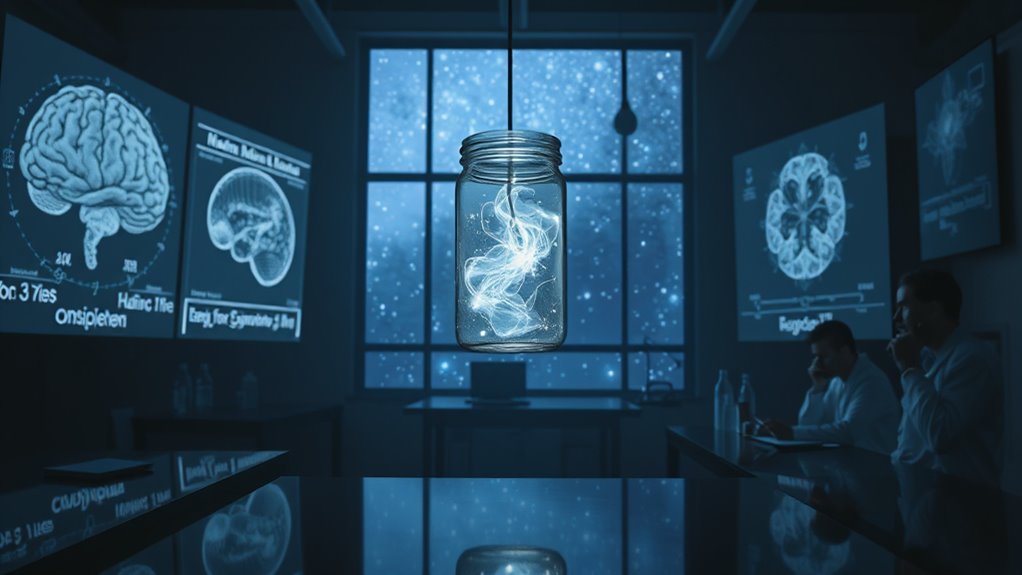Current scientific evidence doesn’t support life after death, with most studies indicating consciousness ceases upon biological death. However, phenomena like near-death experiences (NDEs) and unexpected brain activity post-death challenge this view. Some hypotheses suggest consciousness could exist independently or evolve beyond the body. While the consensus remains skeptical, ongoing research continues to explore these intriguing questions. There’s much more to uncover about consciousness and its potential connections to life after death.
Key Takeaways
- The scientific consensus remains skeptical of life after death, primarily due to a lack of conclusive evidence supporting its existence.
- Near-death experiences (NDEs) suggest some form of consciousness may persist post-death, but interpretations vary widely across cultures.
- Advancements in EEG and MRI technologies have shown unexpected brain activity shortly after death, indicating potential lingering consciousness.
- Various hypotheses, including quantum mechanics, propose that consciousness may exist independently from the brain and continue after physical death.
- Future research is needed to systematically explore consciousness at the edge of death and its implications for understanding life after death.
Current Scientific Consensus on Afterlife Evidence

While many people contemplate the existence of life after death, the current scientific consensus leans toward skepticism due to a lack of conclusive evidence. Studies reveal that cellular activity doesn’t stop immediately upon death, and there’s evidence of sudden brain activity shortly after. This spike may suggest some form of consciousness or lucid experience. Notably, biological processes may continue even after a person is declared dead, indicating that there is no definitive line between life and death. Some scientists theorize that this heightened brain activity could serve as a neural marker for hyperconscious experiences. Additionally, the exploration of mindfulness practices may offer insights into how consciousness could be perceived during these moments, but without direct evidence of life beyond biological death, such interpretations remain speculative. Many in the scientific community emphasize the need for empirical data to validate claims about an afterlife, highlighting the ongoing debate between personal beliefs and scientific inquiry into consciousness and death. Recognizing patterns of emotional detachment in relationships may also shed light on how individuals process loss and the concept of an afterlife. Understanding the balance between individual rights and the collective good is essential in discussions around ethical considerations of life and death. Furthermore, awareness of filial responsibility laws can influence how families approach end-of-life planning and support, potentially impacting their beliefs about what happens after death. Importantly, the emotional impact of loss can be profound, often leading individuals to seek closure in their understanding of existence beyond life.
Understanding Near-Death Experiences (NDEs)

What happens when someone experiences a near-death experience (NDE)? You might feel a sense of leaving your body, often described as an out-of-body experience (OBE). Many report passing through tunnels or encountering deceased loved ones and spiritual beings.
NDEs can be emotional, cognitive, spiritual, or supernatural, and they occur during life-threatening events. About five percent of people worldwide have had these transformative experiences, which are reported across cultures and backgrounds. Notably, a majority of students believe in life after death, indicating a strong belief in the possibility of existence beyond our physical lives. This phenomenon may also be linked to supernatural lore, as many cultures have their own interpretations of what happens after death. Affairs, both physical and virtual, can significantly impact individuals’ perceptions of life and relationships, often leading to profound emotional distress. Understanding the role of therapy in processing these experiences can further aid individuals in integrating their NDEs into their lives. Additionally, the support provided by family caregivers can play a crucial role in helping individuals navigate the emotional aftermath of an NDE. Many of these experiences can also lead to a renewed appreciation for life and a desire for creative processes that enhance personal growth.
After an NDE, you may undergo profound personal changes, leading to increased spirituality and a new outlook on life. While debates continue about whether NDEs signify life after death or are mere hallucinations, their vivid nature urges serious consideration of these extraordinary experiences.
Theoretical Hypotheses About Consciousness

Is There Scientific Evidence for Life After Death?
Theoretical Hypotheses About Consciousness
Near-death experiences (NDEs) raise intriguing questions about consciousness and its potential existence beyond physical life. One hypothesis links consciousness to quantum mechanics, suggesting it might exist independently of brain activity. While this idea is fascinating, it lacks solid empirical support, leading to skepticism among scientists. NDEs involve sensations like leaving the body and encountering beings of light, highlighting the profound experiences reported by those who have undergone such events. Additionally, some researchers speculate that consciousness may parallel solar energy systems, which optimize energy usage and have complex interactions with their environments. Celebrating relationships with unconditional love can also foster deeper connections that transcend our understanding of consciousness. Engaging in music therapy has been shown to enhance emotional well-being, suggesting that experiences of connection may play a role in our understanding of consciousness. Furthermore, the growing trend of sustainable fashion reflects a societal shift towards deeper values that could influence our perception of existence. Importantly, the insights gained from predictive modeling might also help us understand how data on consciousness could be analyzed for potential connections to experiences after death.
Other theories propose that consciousness could survive physical death, existing beyond the body, but they face challenges due to the subjective nature of consciousness.
Additionally, simulation theory posits that our reality might be a crafted illusion, with death merely a change.
Finally, some believe consciousness evolves into new forms of life, potentially connecting to a cosmic process.
Each hypothesis remains speculative, needing rigorous exploration to validate their claims.
Biological Death and the Possibility of Resuscitation

Understanding biological death and the potential for resuscitation is crucial, as it bridges the gap between life and the unknown.
Clinical death occurs when circulatory and respiratory functions stop, but it’s often reversible with timely medical intervention. However, biological death signifies irreversible cessation of all biological functions. Mammography aims to detect breast cancer early for better treatment outcomes, underlining the importance of timely interventions in health. The concept of high refresh rates is similarly critical in gaming, where rapid responses can make a significant difference. Furthermore, the use of energy-efficient models in heat pumps exemplifies how technology can enhance our living environments, paralleling advancements in medical interventions. Additionally, understanding required minimum distributions can play a role in financial planning for those who may wish to allocate resources for potential medical emergencies.
If someone suffers cardiac arrest, early intervention, such as CPR, is essential; you typically have 10-15 minutes for successful resuscitation. Studies show that while CPR can restore circulation, recovery rates drop considerably after prolonged heart inactivity. Recent findings suggest that advanced filtration systems can improve air quality, which may indirectly support overall health and resilience during medical emergencies.
Curiously, some patients display brain wave activity during CPR, suggesting conscious thought might persist briefly. Cases of spontaneous recovery, known as the Lazarus phenomenon, further complicate our understanding of death and resuscitation possibilities.
Advances in Scientific Tools and Methods

As researchers explore deeper into the mysteries surrounding life and death, advances in scientific tools and methods are reshaping our understanding of consciousness during critical moments.
Modern techniques like EEG and MRI reveal unexpected brain activity shortly after death, suggesting a possible persistence of consciousness. The AWARE study highlights that some patients retain awareness during cardiac arrest, challenging traditional views on clinical death. Recent research indicates that brain activity may continue for a short period after the heart stops, further supporting the notion of lingering consciousness. Additionally, studies on effective relaxation techniques are being integrated into the understanding of near-death experiences, showcasing how mental states might influence perceptions of consciousness at the edge of death. Moreover, AI technologies are improving data analysis methods in these studies, enhancing our understanding of the physiological changes associated with near-death experiences. The integration of intelligent tutoring systems in educational settings also exemplifies how technology can transform traditional approaches to learning, paralleling the innovation occurring in consciousness research. Understanding the effects of sugar content in various diets, for instance, can provide insights into how physical health impacts mental states.
Advanced diagnostics also track physiological changes at death’s edge, uncovering high-frequency brain activity that might indicate transient consciousness. Additionally, psychological investigations into near-death experiences show common themes and significant impacts on individuals’ mental health.
These tools and insights are paving the way for a new understanding of life, death, and what may lie beyond.
Philosophical and Theological Perspectives

While the question of life after death has intrigued humanity for centuries, philosophical and theological perspectives offer diverse interpretations that shape our understanding of existence beyond the grave.
Platonic dualism suggests your soul continues after death, while Epictetian stoicism argues that death marks consciousness’ end. Cartesian dualism supports the idea of a persistent soul distinct from the body.
Theological views, like Christian resurrection and Islamic beliefs, promise an afterlife based on divine judgment. In contrast, nihilistic philosophies emphasize living fully in the present. Indifference towards future annihilation is considered ethically perverse, fostering deeper reflections on the implications of afterlife beliefs.
Near-death experiences, debated yet compelling, hint at a continued sense of self. Each perspective invites you to explore the profound questions surrounding life, death, and what may lie beyond.
Future Directions for Research on Consciousness and Death

Exploring future directions for research on consciousness and death opens up exciting possibilities that could reshape our understanding of existence. You’ll find that existing studies, including brain imaging and near-death experiences (NDEs), provide a foundation for deeper investigation. Research into quantum consciousness may reveal how consciousness interacts with the physical world. Clinical studies, like those from the University of Southampton, indicate that many patients retain memories during clinical death, challenging conventional views. Future efforts should focus on collecting systematic data about NDEs and developing a cross-disciplinary approach among neuroscience, psychology, and anesthesiology. Additionally, findings that 40% of clinically dead individuals reported memories suggest the need for further exploration into the nature of consciousness during and after death.
Frequently Asked Questions
Are There Documented Cases of Verified Afterlife Experiences?
Yes, there are documented cases of verified afterlife experiences, particularly through near-death experiences (NDEs).
You’ll find that many individuals report vivid, transformative experiences that include accurate observations during their clinical death.
These cases often involve specific details that can be verified by medical staff or witnesses.
Such experiences challenge conventional views on consciousness and suggest a deeper exploration into what happens after life, raising intriguing questions about existence beyond our physical reality.
How Do Cultural Beliefs Influence Perceptions of Life After Death?
Cultural beliefs shape your perceptions of life after death in profound ways.
For instance, if you belong to a religion that emphasizes an afterlife, you might feel less anxious about death, viewing it as a passage. In contrast, if your culture celebrates ancestors, you might see the deceased as guiding spirits.
These various beliefs not only influence how you cope with death but also affect rituals, social interactions, and your overall understanding of existence.
What Role Do Dreams Play in Beliefs About the Afterlife?
Dreams play a significant role in shaping your beliefs about the afterlife. They often serve as a bridge between the physical and spiritual worlds, allowing you to feel connected to deceased loved ones.
When you experience vivid dreams about death or change, they can provide comfort and reinforce your ideas about continuing existence. These dreams can evoke strong emotions, influencing how you perceive life after death and shaping your cultural narratives about spirituality.
Can Meditation or Spiritual Practices Affect Perceptions of Consciousness?
What if the way you perceive consciousness could change with just a few moments of stillness?
When you meditate, you tap into altered states that might expand your awareness beyond the physical domain. You might feel a sense of unity or detachment, transforming how you experience your own consciousness.
Regular practice can deepen these insights, leading to profound shifts in your understanding of self and reality, challenging everything you thought you knew.
How Do Psychological Factors Shape Near-Death Experience Interpretations?
Psychological factors markedly shape how you interpret near-death experiences (NDEs). Your personal beliefs, cultural background, and emotional resilience all play a role.
For instance, you might perceive NDEs based on what you expect or fear about death. Additionally, feelings of detachment or depersonalization can influence how vivid or real these experiences seem to you.
Ultimately, your mind’s response to stress and trauma can color your narrative of the NDE, making it uniquely yours.
Conclusion
In the grand tapestry of existence, the question of life after death weaves a thread of mystery that ignites our imaginations. While science grapples with near-death experiences and consciousness, we’re left dangling on the edge of a cosmic cliff, peering into the abyss of the unknown. As the universe expands and our tools sharpen, who knows what dazzling revelations await? Perhaps one day, we’ll dance with the echoes of the departed, unraveling the secrets of eternity itself.









